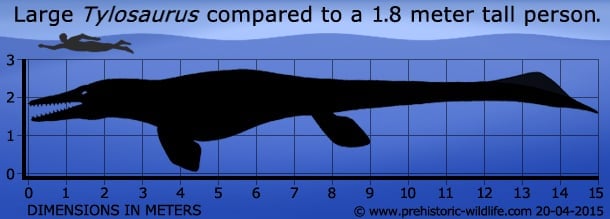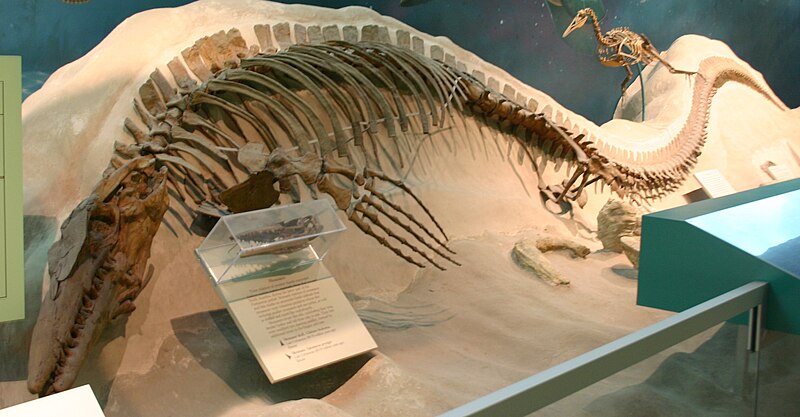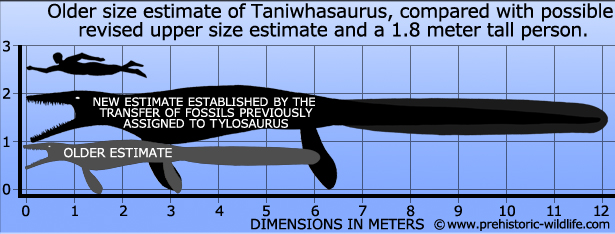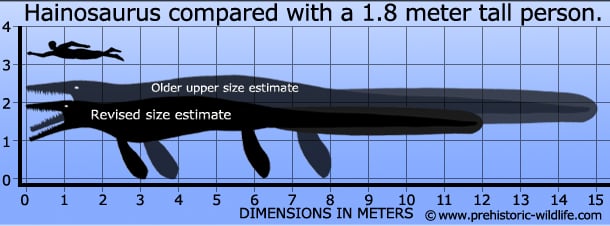[Recent Entries][Archive][Friends][User Info]
Below are the 3 most recent journal entries recorded in the "Сообщество, посвящённое ра" journal:| February 15th, 2014 | |
|---|---|
| 10:36 am [industrialterro] [Link] |
Tylosaurus Тилозавры (Tylosaurus от др.-греч. τύλος «деревянный гвоздь, шип» и σαῦρος «ящерица») — род гигантских мозазавров мелового периода. Одни из самых известных и крупных мозазавров. Род описан Г. Ч. Маршем в 1872 году; название выбрано, вероятно, из-за вытянутого рыла. Интересно, что типовой вид был описан в 1869 году Э. Д. Коупом, соперником Марша из отложений Канзасского Мелового моря. Но Коуп отнес животное к роду Macrosaurus, а это название было уже «занято». Позднее он же отнес типовой образец к малоизвестному европейскому роду Liodon. Остатки тилозавров широко распространены в отложениях позднего мела США, поэтому их описывали под самыми разными названиями (Rhamphosaurus, Rhinosaurus). Тилозавры — огромные хищные мозазавры, известные по множеству черепов и относительно полных скелетов. Зубы уплощены изнутри, наружная их поверхность закруглена, эмаль на внутренней поверхности исчерчена. Череп лёгкий, очень кинетичный, что позволяло глотать крупную добычу. Кончик ростра лишён зубов, именно эта особенность и дала название ящеру. В реальности, вероятно, ростр был сосредоточием чувствительных нервных окончаний, возможно, и электрорецепторов, позволявших охотиться в темноте больших глубин. Известны находки черепов со сломанным при жизни ростром (вместо него развилась костная грибовидная мозоль) — вероятно, животное с разгону налетело на скалу. Зубы на птеригоидах помогали проталкивать добычу в глотку. Скелет тилозавра тоже довольно лёгкий. Он содержит 29—30 предкрестцовых позвонков, 6—7 крестцовых, 33—34 хвостовых с «шевронами», 56—78 терминальных хвостовых. Грудная клетка бочкообразная, есть хрящевая грудина (известны отпечатки хрящей). В толще рёбер обнаружены участки аваскулярных некрозов (признак перенесённых при жизни глубоких погружений) и остеопороза. Ласты относительно узкие. Отпечатки кожи показывают наличие ромбических мелких чешуек с килями и гребнями, причём чешуи у 8—9 метрового тилозавра были мельче, чем у гремучей змеи средних размеров (у тилозавра 90 чешуек на квадратный дюйм, а у змеи — всего 80). Известны остатки содержимого желудка — остатки акул, костных рыб, птицы Hesperornis и мелкого мозазавра Clidastes. Недавно внутри скелета крупного тилозавра обнаружили кости небольшого короткошеего плезиозавра-поликотилида, а первые упоминания о таких находках относятся к 1918 году. По-видимому, тилозавры были неспециализированными хищниками, атаковавшими любую подходящую добычу. Известно не менее 8—10 видов тилозавров. Наиболее изучены: Tylosaurus proriger — типовой вид, описанный Коупом на основании почти полного черепа и нескольких позвонков из позднего мела Западного Канзаса. Образец был обнаружен «полковником Коннингемом и мистером Майнором» в районе Долины Монументов в 1868 году. Голотип утерян. По-видимому, этот самый известный вид является и самым крупным: известны черепа до 1,5 метров длиной и полные скелеты не менее 14 метров (например, «Банкерский тилозавр»). Происходит из сантона-кампана Северной Америки, преимущественно Канзаса. Широко упоминаемый в старой литературе Tylosaurus dyspelor является, по-видимому, синонимом типового вида. Tylosaurus nepaeolicus — описан Коупом в 1874 году. Происходит с реки Непахолла (ныне река Соломон на севере Канзаса). Более древний (коньякский век) и мелкий вид, до 9 метров в длину. Череп относительно выше и короче, чем у типового вида. Tylosaurus kansensis — описан М. Эверхартом в 2004 году из коньякских отложений Канзаса (Смоки Хилл), причем дополнительный материал был выявлен в уже существующих музейных коллекциях, где находился с XIX века. Длина до 7 метров. Оба более ранних вида тилозавра характеризуют так называемую формацию Ниобрара, чрезвычайно богатую остатками морских рептилий. Остатки тилозавров обнаружены в коньякских — кампанских отложениях по всему свету. Они известны из Северной и Южной Африки (T. capensis), Японии и Европы. Ряд европейских и американских видов, ранее отнесенных к роду хайнозавр, оказались тилозаврами. Впрочем, все тилозаврины (подсемейство мозазавров, куда входят тилозавр, хайнозавр, горониазавр, лакумазавр и танивазавр) весьма сходны между собой. Так, танивазавр (Taniwhasaurus oweni) из маастрихта Новой Зеландии был известен также как Tylosaurus haumuriensis и лишь в 1999 году было показано, что остатки новозеландских тилозавров принадлежат к одному виду и роду. Лакумазавр (Lakumasaurus antarcticus) был описан в 2002 году из маастрихта антарктического острова Сеймур. Вероятно, он относится к роду Taniwhasaurus. Недавно остатки этого рода найдены и в Японии. Фрагментарные остатки, отнесенные к тилозаврам, известны и из меловых отложений России и бывшего СССР. Вид T. riapaeus описан Боголюбовым из кампана Оренбуржья, но может и не принадлежать к этому роду. Тилозавр отмечен также для кампана Саратовской и Волгорадской области, из кампанских отложений реки Коноплянка вблизи Орска и из маастрихта Крыма. Таким образом, тилозавры были весьма распространены в конце мелового периода, представляя особую ветвь гигантских мозазавров. Along with plesiosaurs, sharks, fish, and other genera of mosasaurs, it was a dominant predator of the Western Interior Seaway during the Late Cretaceous. Tylosaurus proriger was among the largest of all the mosasaurs (along with Hainosaurus and Mosasaurus hoffmannii), reaching maximum lengths of 15 meters or more (49+ ft). A distinguishing characteristic of Tylosaurus is its elongated, cylindrical premaxilla (snout) from which it takes its name and which may have been used to ram and stun prey and also in intraspecific combat. Early restorations showing Tylosaurus with a dorsal crest were based on misidentified tracheal cartilage, but when the error was discovered, depicting mosasaurs with such crests was already a trend. Stomach contents associated with specimens of Tylosaurus proriger indicate that this ferocious mosasaur had a varied diet, including fish, sharks, smaller mosasaurs, plesiosaurs, and flightless diving birds such as Hesperornis. In some paleoenvironments, Tylosaurus seems to have preferred shallow, nearshore waters (as with the Eutaw Formation and Mooreville Chalk Formation of Alabama), while favoring deeper water farther out from shore in other environments (as with the Niobrara Chalk of the western U.S.). The Talkeetna Mountains Hadrosaur was a hadrosaurid of indeterminate classification whose carcass appeared to have been deposited in a bathyal or outer shelf environment that later became Alaska's Matanuska Formation. Every element of its skeleton not found in a concretion bore many closely spaced ovualar conical depressions ranging in diameter from 2.12 to 5.81 mm and 1.64 to 3.62 deep. These depressions are probably bite marks. The depressions are not symmetrical enough for gastropod drill marks and are not shaped like sponge borings. None of the preserved fish fossils of the Matanuska Formation fit the size or geometry of the borings. The size and spacing and shape by contrast, however, closely resembles the teeth of Tylosaurus proriger. The apparent tooth marks are unlikely to have occurred before the carcass was washed out to sea since that would have punctured the body, preventing the build up of bloating gases that allowed the carcass to drift out to sea in the first place. The distribution of bite marks corresponds inversely to the presence of flesh in the animal. For instance, lower limb bones sustained the most damage because there was the least amount of flesh shielding the bones at those locations. The concretions formed as the flesh chemically reacted to the seafloor on the largest parts of the animal where the scavenging mosasaur would be unable to fully wrap its jaws around the carcass. Bones pulled free from the carcass were buried in the mud and preserved in mudstone Like many other mosasaurs, the early history of this taxon is complex and involves the infamous rivalry between two early American paleontologists, Edward Drinker Cope and Othniel Charles Marsh. Originally, the name "Macrosaurus" proriger was proposed by Cope for a fragmentary skull and thirteen vertebrae collected from near Monument Rocks in western Kansas in 1868. It was placed in the collections of the Harvard Museum of Comparative Zoology. Only a year later, Cope redescribed the same material in greater detail and referred it, instead, to the English mosasaur taxon Liodon. Then, in 1872, Marsh named a more complete specimen as a new genus, Rhinosaurus ("nose lizard"), but soon discovered that this name had already been used for a different animal. Cope suggested that Rhinosaurus be replaced by yet another new name, Rhamposaurus which also proved to be preoccupied. Marsh finally erected Tylosaurus later in 1872, to include the original Harvard material as well as additional, more complete specimens which had also been collected from Kansas. A giant specimen of T. proriger, recovered in 1911 by C. D. Bunker near Wallace, Kansas is one of the largest skeleton of Tylosaurus ever found. It is currently on display at the University of Kansas Museum of Natural history. In 1918, Charles H. Sternberg found a Tylosaurus, with the remains of a plesiosaur in its stomach. The specimen is currently mounted in the United States National Museum (Smithsonian) and the plesiosaur remains are stored in the collections. Although these important specimens were briefly reported by C. H. Sternberg (1922), the information was lost to science until 2001. This specimen was rediscovered and described by Everhart (2004a). It is the basis for the story line in the new (2007) National Geographic IMAX movie - Sea Monsters, and a book by the same name (Everhart, 2007). A photograph of a Tylosaurus skull was taken by George F. Sternberg about 1926 after he collected and prepared the specimen. It was discovered in the Smoky Hill Chalk of Logan County, Kansas. Sternberg offered the specimen to the Smithsonian and included a photograph in his letter to Charles Gilmore. Copies of the original photos are in the archives of the Sternberg Museum of Natural History (FHSM). The specimen is FHSM VP-3, the exhibit specimen in the same museum. A 34 ft. long Tylosaurus found in Kansas by Alan Komrosky in 2009 is now on display at the Museum of World Treasures in Wichita, Kansas. Репродукции (1, 2, 3, 4, 5, 6, 7, 8, 9, 10, 11, 12, 13, 14, 15, 16, 17): ( Read More ) Размеры тела в сравнении с человеком: Ископаемые останки (1, 2, 3, 4, 5, 6, 7, 8, 9, 10, 11, 12): ( Read More ) Tags: Вымершие рептилии, Мел, варанообразные, диапсиды, лепидозавроморфы, лепидозавры, мозазавриды, мозазавроиды, тилозавры, чешуйчатые, ящерицы |
| February 14th, 2014 | |
| 07:55 pm [industrialterro] [Link] |
Taniwhasaurus Taniwhasaurus (From the Maori Taniwha, a supernatural, aquatic creature, and the Greek σαυρος/sauros, meaning lizard) is an extinct genus of mosasaur, a carnivorous, marine reptile which inhabited New Zealand, Japan and Antarctica. The genus was a close relative of the genera Tylosaurus and Hainosaurus. Taniwhasaurus oweni, the type species for Taniwhasaurus, was named by Hector in 1874 from a fossil specimen found in the late Campanian Conway Formation outcrops at Haumuri Bluff, New Zealand. Known from an individual that may have measured at least 20+ feet in length, based on the estimations of the remains found. It is synonymous with Tylosaurus haumuriensis, which was named more recently, from the front parts of the jaws. The genus Lakumasaurus was described in 2002 by Novas et al. from a fossil specimen found in the Santa Marta Formation of James Ross Island, Antarctica. When the type material was reexamined in 2007, James E. Martin and Marta Fernández determined Lakumasaurus to be a junior synonym of Taniwhasaurus and recombined the species Lakumasaurus antarcticus as T. antarcticus. "Yezosaurus" was the name given to an undescribed genus of prehistoric marine reptile. Originally thought to be a theropod dinosaur, it was later identified as a mosasaur or ichthyosaur which lived in what is now Japan. The "type species", "Yezosaurus mikasaensis", was coined by Obata and Muramoto in 1977, but was not formally described until 2008, when the species T. mikasaensis was described by M.W. Caldwell et al. Размеры тела в сравнении с человеком (старая и новая оценка): Tags: Вымершие рептилии, Мел, варанообразные, диапсиды, лепидозавроморфы, лепидозавры, мозазавриды, мозазавроиды, тилозавры, чешуйчатые, ящерицы |
| January 29th, 2014 | |
| 02:10 pm [industrialterro] [Link] |
Hainosaurus Хайнозавр или гайнозавр, айнозавр, энозавр (Hainosaurus, от др.-греч. αἰνός σαῦρος «жуткий ящер») — гигантский мозазавр позднемеловой эпохи. Ближайший родственник североамериканского тилозавра, вместе с ним входит в подсемейство Tylosaurinae. Назван Луи Долло в 1882 году в честь реки Хайна (Эно) в Бельгии, где были найдены остатки типового вида. От тилозавра отличается большей длиной носовых отверстий и более удлиненным телом. Более 53 позвонков от головы до начала хвоста (у тилозавра — 35), но хвост относительно короче. «Шевроны» на хвостовых позвонках не сочленены с телами позвонков. Кончик ростра лишен зубов, ранее предполагалось, что он использовался как «таран», но слабый легкий череп противоречит такому заключению. Зубы уплощенные, с двумя режущими кромками (в отличие от «граненых» зубов тилозавра). Размеры огромные — длина черепа более 1,5 метров, общая длина могла превышать 14—15 метров (в литературе указываются размеры до 17 метров). Примерно три вида, следует учесть, что ряд видов хайнозавра из Европы оказались европейскими представителями рода Tylosaurus. Hainosaurus bernardi — типовой вид, назван Л. Долло в честь промышленника Леопольда Бернарда, позволившего производить раскопки в своей фосфатной шахте в Mesvin-Ciply (Бельгия). Голотип представляет переднюю половину скелета с черепом. Маастрихт Бельгии и Франции. Самый крупный вид, до 15—17 метров длиной. Hainosaurus pembinensis — американский вид, описанный Э. Николлс в 1988 году из раннего кампана Пембины в Манитобе (Канада). Известен полный скелет, получивший прозвище «Брюс», хранящийся в музее в Манитобе. Длина скелета около 14 метров. Не исключено, что этот вид принадлежит к роду Tylosaurus, в таком случае в Северной Америке род Hainosaurus не представлен вообще. Хайнозавр был активным и весьма агрессивным хищником. В брюшной полости типового экземпляра обнаружены остатки морских черепах. Интересно упоминание о черепе другого мозазавра — Mosasaurus hoffmanni, разбитом каким-то «тупым орудием» (фигурально выражаясь, кто-то «вышиб ему мозги»). Судя по всему, «орудие» по размерам и форме соответствовало ростру хайнозавра. Впрочем, эта трактовка может быть ошибочной, поскольку, как говорилось выше, череп хайнозавра отличается хрупкостью строения, с наличием многочисленных подвижных соединений между костями. Хайнозавр — один из последних мозазавров, доживший до самой мел-палеогеновой границы. Неопределимые до вида остатки этих мозазавров известны также из позднего мела Швеции, Польши и Волгоградской области. Hainosaurus is an extinct genus of marine lizard belonging to the mosasaur family. It is one of the largest mosasaurs, though its size has been revised more than once. At first it was estimated to be 17 metres (56 ft), and the largest mosasaurid. During the 1990s, its size was revised to 15 metres (49 ft) long; more recently, Johan Lindgren estimated that it reached lengths of up to 12.2 metres (40 ft). It was one of the top marine predators of the Late Cretaceous. Like other giant mosasaurs, this giant predator preyed on turtles, plesiosaurs, pterosaurs, cephalopods, sharks, fish, and smaller mosasaurs. Tylosaurinae is a subfamily of mosasaurs, a diverse group of Late Cretaceous marine lizards. Russell (1967, pp. 170) defined the Tylosaurinae as follows: "Large rostrum present anterior to premaxillary teeth. Twelve or more teeth in dentary and maxilla. Cranial nerves X, XI, and XII leave lateral wall of opisthotic through a single foramen. No canal in basioccipital or basispehnoid for basilar artery. Suprastapedial process of quadrate moderately large, distally pointed. Dorsal edge of surangular rounded and longitudinally horizontal. Twenty nine presacral vertebrae present. Length of presacral series less than that of postsacral series in Tylosaurus, neural spines of posterior caudal vertebrae at most only slightly elongated, do not form an appreciable fin. Haemal arches unfused to caudal centra. Appendicular elements lack smoothly finished articular surfaces." Genera referrable to the Tylosaurinae (informally and collectively known as "tylosaurines" or "tylosaurs") have been found on all continents except Australia and South America. The etymology for the subfamily is derived from the genus of the type species, Tylosaurus. In general, tylosaurs were large-bodied marine lizards armed with sturdy, conical teeth and an elongated premaxilla and extensions of the dentaries that do not bear teeth to the very end such as is found in other genera of mosasaurs. Cope's original concept of a "battering ram" snout is not supported by fossil evidence. Stomach contents from a tylosaur recovered in South Dakota included remains of another mosasaur, a bony fish, the large, flightless seabird Hesperornis, and possibly a shark, indicating that tylosaurs were generalists. Another specimen collected by Charles Sternberg included the bones of a small plesiosaur (see also). Lingham-Soliar suggested that tylosaurines were not among the fastest swimming nor the strongest mosasaurids. However, they are lightly built, having greatly reduced the weight of their bodies and possessing relatively small pectoral and pelvic girdles, fore- and hindlimbs. Their bone is highly cancellous and may have been impregated with fat cells during life, adding buoyancy. These traits suggest that tylosaurs may have been ambush predators. Tylosaurs were among the largest mosasaurs, with some species of Tylosaurus and Hainosaurus reaching lengths of 9-15+ meters, making them among the largest of all marine reptiles. A small species of Tylosaurus reported by Russell, T. "zangerli" has since proven to be a juvenile individual of T. proriger. Everhart erected a third species (T. kansasensis) from the Smoky Hill Chalk. Polcyn and Bell (2005, p. 322) have erected a more inclusive clade, the parafamily Russellosaurina, which includes the "subfamilies Tylosaurinae and Plioplatecarpinae and their sister-clade containing the genera Tethysaurus, Russellosaurus, and Yaguarasaurus." Tylosaurs first appear in the fossil record in the early Coniacian and persist well into the Maastrichtian, a period of approximately twenty million years. Размеры тела в сравнении с человеком: Ископаемые останки (1, 2, 3, 4, 5): Tags: Вымершие рептилии, Мел, варанообразные, диапсиды, лепидозавроморфы, лепидозавры, мозазавриды, мозазавроиды, тилозавры, чешуйчатые, ящерицы |



























